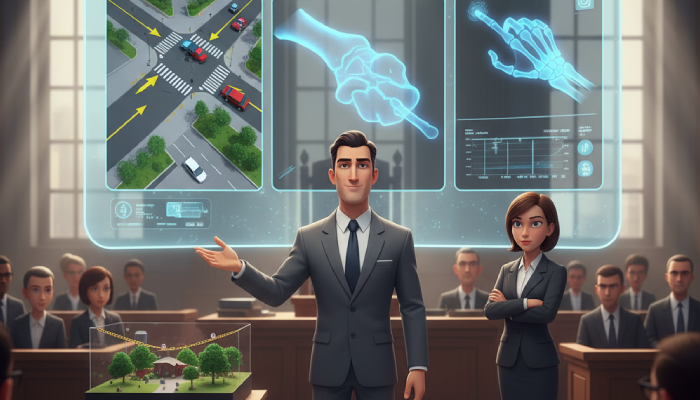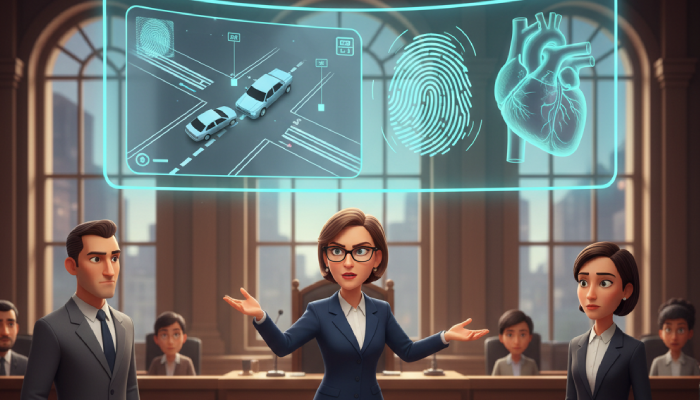In litigation, facts alone aren’t always enough to win your audience over. Even with a strong legal argument, if the jury or judge can’t easily follow your case, you’re already at a disadvantage.
That’s where demonstrative evidence plays a crucial role — turning complex information into a clear and persuasive story. Research shows that visual aids used alongside oral arguments can boost understanding and retention by up to 65%.
To make your case truly memorable, your real evidence and demonstrative evidence must complement each other. When used together effectively, they transform data and testimony into a compelling visual narrative that sticks with your audience long after the presentation ends.
What is Demonstrative Evidence?

Demonstrative evidence refers to visual tools and exhibits used in court to clarify, illustrate, or emphasize facts. These visual aids help simplify complicated details, ensuring the trier of fact fully understands the key elements of your argument.
Because demonstrative evidence supports factual testimony and documentation, it typically enjoys a high rate of admissibility in court.
For example, if a medical expert uses a 3D anatomical model to describe an injury, the model must be accurate and realistic to meet legal standards for admissibility.
Common Types of Demonstrative Evidence
Demonstrative evidence can take many forms, and its flexibility makes it one of the most effective tools in modern litigation. Some of the most frequently used examples include:
- Charts, Graphs, and Timelines
Simplify data, show sequences of events, and make complex information easier to digest. - Product Models
Recreate objects or devices to help the jury visualize how something functions or failed. - Enhanced Photos
Highlight key visual details that might otherwise go unnoticed. - Video Analysis
Provide a step-by-step breakdown of movements, actions, or sequences critical to your case. - Accident Reconstruction Animations
Bring dynamic scenes to life, helping jurors clearly see how incidents occurred. - Legal Graphics
Combine design and data for impactful trial visuals that communicate your message with clarity. - Medical Animations
Visually explain surgical procedures, injuries, or the progression of an illness in a way anyone can understand.
Why Demonstrative Evidence Matters
Demonstrative evidence bridges the gap between technical information and human understanding. It takes abstract facts and transforms them into a story that resonates emotionally and intellectually with the audience.
These visuals don’t replace real evidence — they amplify it. When done right, they ensure that every juror or decision-maker remembers the key points that define your case.
The combination of expert testimony, real evidence, and powerful demonstrative exhibits creates a courtroom experience that is both educational and persuasive
What Is “Real” Evidence in Litigation?

Real evidence—also known as physical evidence—refers to tangible, concrete objects that play a direct role in a legal dispute. These items are typically connected to the incident or event in question and serve as crucial proof during litigation. Examples of real evidence include audio recordings, machinery parts, tools, documents, or even something seemingly insignificant, like a pair of shoes.
While real evidence is always physical in nature, it can sometimes overlap with demonstrative evidence, which is also a tangible item. The distinction lies in the purpose and presentation. For example, photographs can function as both real and demonstrative evidence depending on how they are used in court.
Real evidence can also be considered demonstrative in situations involving:
- X-rays
- Videos or surveillance footage
- Audio recordings
- Photographs of injuries or damages
The key to distinguishing between the two types lies in how the evidence is used and authenticated. If an item is directly tied to the facts of the case and can be proven to be unaltered, it qualifies as real evidence. However, if the same item is primarily used to clarify, illustrate, or enhance understanding of the events, then it serves as demonstrative evidence.
At Legal Animation, understanding the difference between real and demonstrative evidence is essential. Both types work together to build a strong visual and factual foundation—helping juries, judges, and attorneys better comprehend the story behind the case.
Visual Litigation: Civil Cases with Demonstrative Evidence
The close connection between real and demonstrative exhibits makes them powerful storytelling tools in civil litigation. For attorneys, using both types in harmony can dramatically influence how jurors perceive the facts — often leading to more favorable outcomes. When combined, they deliver a complete and compelling narrative, especially when crucial pieces of information exist separately but hold significant meaning when viewed together.
Take, for instance, a vehicle accident civil case involving high speeds and a severe sandstorm. The defense team utilized Legal Animation to recreate the incident with precision. Using verified data about the accident’s landscape and insights from four different experts, the demonstrative animation reconstructed the driver’s exact perspective. This visual approach provided a lifelike account of the event, ultimately revealing that the plaintiff shared partial responsibility for the crash.
If the attorney had relied solely on real evidence, such as physical debris or original photos from the scene, the story would have remained fragmented. Those elements alone could only explain portions of the event. However, the forensic animation brought every factor — from sand density and visibility to lighting and road signage — into a cohesive, dynamic visual.
Through Legal Animation, jurors could clearly see how the accident might have unfolded differently had the plaintiff made alternate decisions. This combination of real and demonstrative evidence didn’t just tell the story — it showed it, turning complex data into a powerful, persuasive narrative.
Admissibility of Demonstrative Evidence
Every type of evidence presented in court must meet strict admissibility standards—and demonstrative evidence is no exception. For visual exhibits to be accepted, they must be relevant, accurate, and free from prejudice. In other words, demonstrative evidence should fairly and clearly represent the facts it illustrates.
Visual exhibits such as evidence animations, 3D reconstructions, and graphic timelines can powerfully support testimony and make complex information easier to understand. When produced by an experienced forensic animation studio, demonstrative visuals based on verified data have a remarkably high rate of courtroom acceptance—up to 99%.
In high-stakes litigation, clarity can make all the difference. A single well-crafted accident reconstruction once led to a $550,000 increase in settlement value, delivering a 20x return on investment for the attorney involved. That’s the tangible power of clear, credible visual storytelling.
The Real Difference Between Real and Demonstrative Evidence
Too often, demonstrative evidence is treated as an afterthought—created only when trial dates are approaching. But strategic planning early in the case can be a game-changer.
By placing the judge or jury directly at the scene, a well-designed animation or exhibit brings the facts to life, strengthening the story behind real or testimonial evidence. When used thoughtfully, demonstrative visuals not only clarify complex details but can also sway the outcome in your client’s favor.
Simple, unbiased graphics help viewers understand what truly happened—free from confusion or speculation. The more clearly the court understands your case, the more informed their decisions will be regarding liability and damages.
With years of experience and expertise, Legal Animation has developed realistic courtroom visuals and compelling law animation services used in over 2,000 cases. Their evidence-based approach has helped attorneys achieve a 99% admissibility rate across diverse case types.


